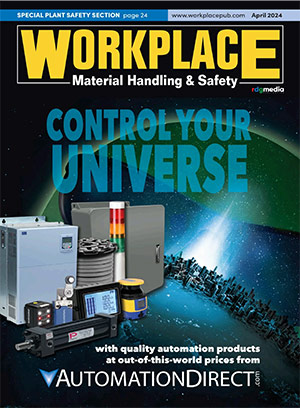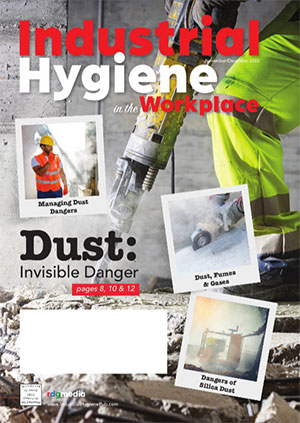Protective Guards & Barriers: Prevent Accidents, Product Damage
Barbara Nessinger, Chief Editor

To prevent workers from straying into areas with active forklift traffic, pedestrian barriers can reduce vehicle/pedestrian crossover points and clearly segregate vehicle routes from pedestrian walkways. (photo courtesy BoPlan USA Inc.)
Product inventory in a warehouse shares space with both people and equipment. When anything moves from one place to another, there is a risk of accident or injuries to people and/or the possibility of damage to the product or facility. The installation of appropriate protective barriers and guards can help prevent these negative consequences.
Protective guarding refers to anything that will help preserve the longevity of a facility and its existing infrastructure, including the people within it. Typically, protective barriers are installed to designate the edges of pedestrian walkways and paths for moving equipment (i.e., hand trucks and forklifts) by separating work areas from travel areas. They also serve to set off space around equipment, and along doorways and walls within warehouses. Barriers and guards protect employees, inventory, support structures, racking, machinery and vehicles—as well as structural elements in the warehouse, such as walls, columns, docks, floor, etc.).
Barriers assist workers by letting them know where walking is safe and where moving equipment might be operating. Barriers can better direct traffic flow, so vehicles can efficiently collect and deliver goods without crossing into pedestrian walkways; barriers/guardrails also prevent unnecessary contact with equipment and facility structures.
Protective guarding varies, based on the type of facility that requires fortification—be it a retail, distribution or manufacturing facility.
Focus on Warehouses & Distribution Centers
Manufacturing warehouses and distribution centers usually contain many racking shelves for storage. They also tend to have narrower aisles (to maximize rack capacity) and lots of fast-moving traffic, both foot and forklift. Therefore, the protective needs of these facilities differ from those of retail sites, which are designed with completely different goals.
Also unlike retail facilities, manufacturing and distribution centers are usually much bigger; this means different departments (and equipment) are more spread out. These facilities focus on the shipping areas, receiving areas, loading bays and docks. They often don’t have many defined pedestrian areas. Most movement within the facility flows back and forth from an epicenter, so traffic is denser along these routes. Automation has led to an increase in large machinery; this can cause danger, if not sectioned off. Moreover, employees need to understand the hazards and follow simple safety rules.
Manufacturing warehouses require products such as bollards, rack protection and crash barriers. These types of protective guards are designed to defend people, racks and other manufacturing assets from high-impact collisions.
Companies, naturally, want to reduce maintenance costs on internal structures caused by forklift truck impacts and also provide a safe working environment for employees, pedestrians and vehicle drivers. For this purpose, appropriate barriers include pedestrian barriers with gates, column protectors, rack guards, curb barriers, traffic barriers and dock rollers.
To prevent workers from straying into areas with active forklift traffic, pedestrian barriers can reduce vehicle/pedestrian crossover points and clearly segregate vehicle routes from pedestrian walkways. Green gates can be fitted into walkways at convenient safe-crossing points. Column protectors should be installed far enough from the actual structures to keep vehicles from hitting them directly, but also to absorb impact when vehicles get too close.
Before selecting specific barrier/protective guarding products, safety staff should look at the following: how they will handle facility temperatures; product strength, mounting and anchoring styles; electricity needs; barrier offset requirements; required height and length; the weight and speed of moving objects; and whether lights or audible signals are required.
It’s important to address these questions in order to get the appropriate products for your specific needs. Many companies provide custom-designed products tailored for special situations and purposes. Although yellow is often the most popular, universal “safety” color, most barrier products are available in orange and red as well. They can usually be manufactured in any color at an extra charge.
Retail Facilities: Lower Impact, Lower Speeds
The main difference between retail facility collisions and those in a manufacturing facility has to do with speed and impact. Retail facilities have far more frequent low-impact, low-speed mishaps, mainly because such places are generally smaller with more pedestrian lanes and foot traffic. Bumpers might be used to prevent shopping- or stock-cart inflicted damage to shelves, refrigerated cases, fixtures and kiosks. Retail protective guarding also includes corner guards, loading door protectors and cart stops.
Ask the Experts
Taking the extra step of adding barriers or protective guarding usually means cost-savings and safety improvements that begin on the day of installation. The Protective Guarding Manufacturers Association (ProGMA) Product Group of MHI is made up of leading solution providers of many kinds of guarding products designed to protect personnel, equipment, inventory and the facility. ProGMA (mhi.org/progma) is a resource for the hundreds of different types of protective guarding solutions for manufacturing and distribution facilities. WMHS




